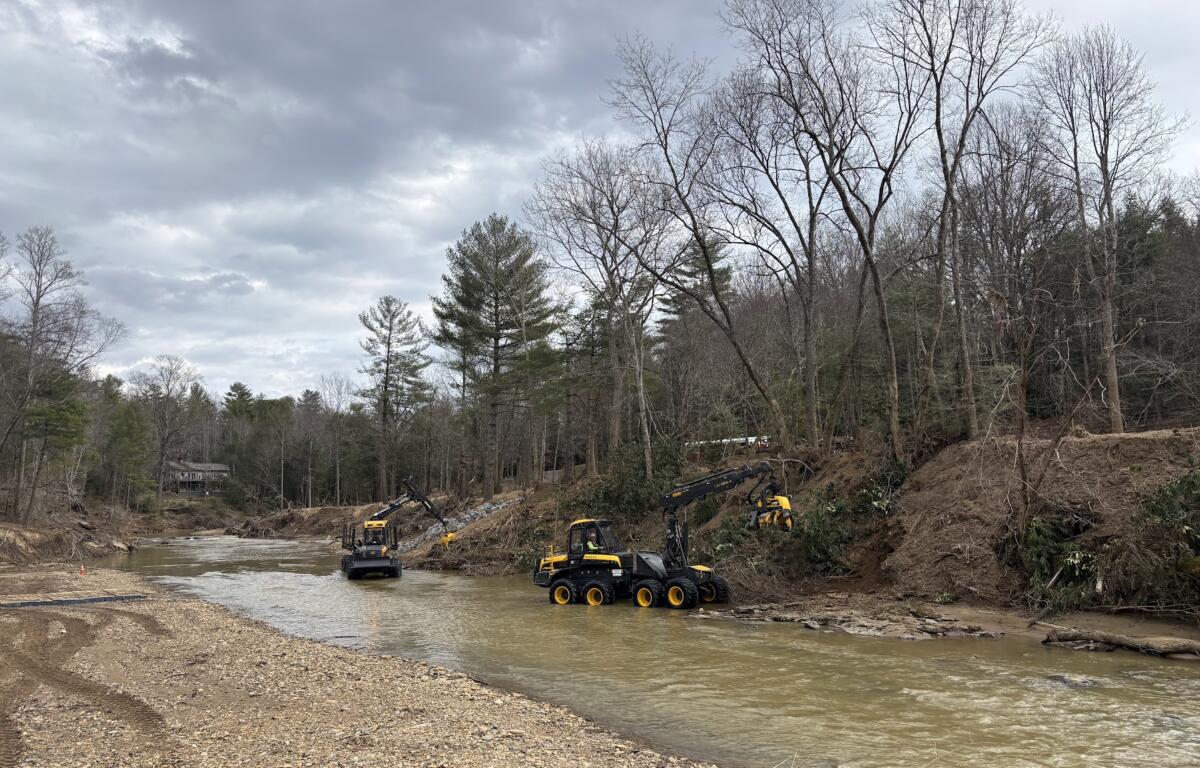ASHEVILLE, N.C. (828newsNOW) — Restoring Asheville to normal after the destruction caused by Hurricane Helene has been a long and laborious process, but the U.S. Army Corps of Engineers held a press conference today at an active cleanup site to update the public on their progress.
The meeting was held around 3:30 p.m. at a Swannanoa River access point along Old Farm School Road. Workers in bright vests and hard hats stood vigilant as large machinery picked up massive tree trunks and fallen limbs from the far riverbank, depositing them into transport trucks on the other side.
“This is one of our sites where we started our waterway debris removal mission. We got started here within Buncombe County back on Saturday, we just started at this site here just west of Warren Wilson College here on the Swannanoa River,” said USACE Corporal Brad Morgan. “We also have some specialized pieces of equipment behind me. These are both called Ponsses.”

The Ponsse machines resembled grapple trucks with their long arm and claw. However, these trucks had a special difference.
“Got a very specialized head on one really focused on the vegetative debris right now,” Morgan said, referring to a saw attached to the Ponsse claw that allowed the machine to cut logs it grabbed. “Some of those logs that are blocking the floodway, blocking the waterway, getting those pulled, cut to size. Then, we’ll bring them out to a strategic ingress location.”
AshBritt Senior Vice President Rob Ray has worked in the disaster recovery industry for 23 years. Ray was present at the work site along the Swannanoa River and was struck by the damage.
“This is the worst flooding damage I’ve ever seen,” Ray stated.

The cleanup method that Morgan and his team are using is specifically designed to prevent further harm to the river and surrounding area. The trucks are using biodegradable hydraulic fuel to prevent harm to the environment in case of a fuel spill and the river banks machinery is hauling over are covered with timber matting to avoid further degradation.
“We’ll also have a boom to be able to catch any debris, floating debris, or minimize the impact of any type of other potential spill or anything like that within the water,” Morgan said.
After six days, Morgan and his team had already cleared 16,000 cubic yards of debris from the Buncombe County waterways.
Buncombe County Solid Waste Director Dane Pedersen provided the numbers on the level of progress across the county.
“I can tell you that since this transition from our partners with North Carolina Emergency Management to FEMA to the Corps of Engineers now, I just talked to Rob, the contractor with AshBritt, there’s been approximately 1 million cubic yards moved,” said Pedersen. “There was a lot of work and effort, and I’m thankful to see where we’re at now in the process, because our community members need to see this. They need to see this debris getting removed and our communities continue to recover from this storm.”

Morgan projected that staff would continue to increase within the next week, growing from 10 crews this weekend to 20 to 25 next week.
“We’ll continue to ramp up that production to work as effectively and as minimally invasively as possible,” Morgan said.
Morgan said that the USACE was working closely with FEMA, subcontractor Ashbritt Inc. and Buncombe County crews to get the work done.
“We’ve got the entire team. Obviously, I’m here working in support of FEMA. FEMA provides me mission assignments to the Corps of Engineers to do the work,” Morgan said. “I think the additional focus that we’re getting both from the state and national level is always beneficial.”

Morgan had a clear target deadline for completion of the waterway cleanup project.
“The mission you see behind me, the waterway mission, our target for completion is June 1. For our private property debris removal mission, our target is June 30,” Morgan said.
It’s an ambitious goal for a region with this degree of destruction, but Pedersen was optimistic.
“There’s a lot of work to be done. I’m encouraged by it,” Pedersen said about the projection. “Water operations, they’re tough. They’re wet, everything’s heavy, but we know, we see the efforts that are being made. We see the commitments. So, I’m encouraged by it and I’m glad to hear the date.”
For more information about the U.S. Army Corps of Engineers project, visit www.saw.usace.army.mil/Missions/HeleneResponse.



